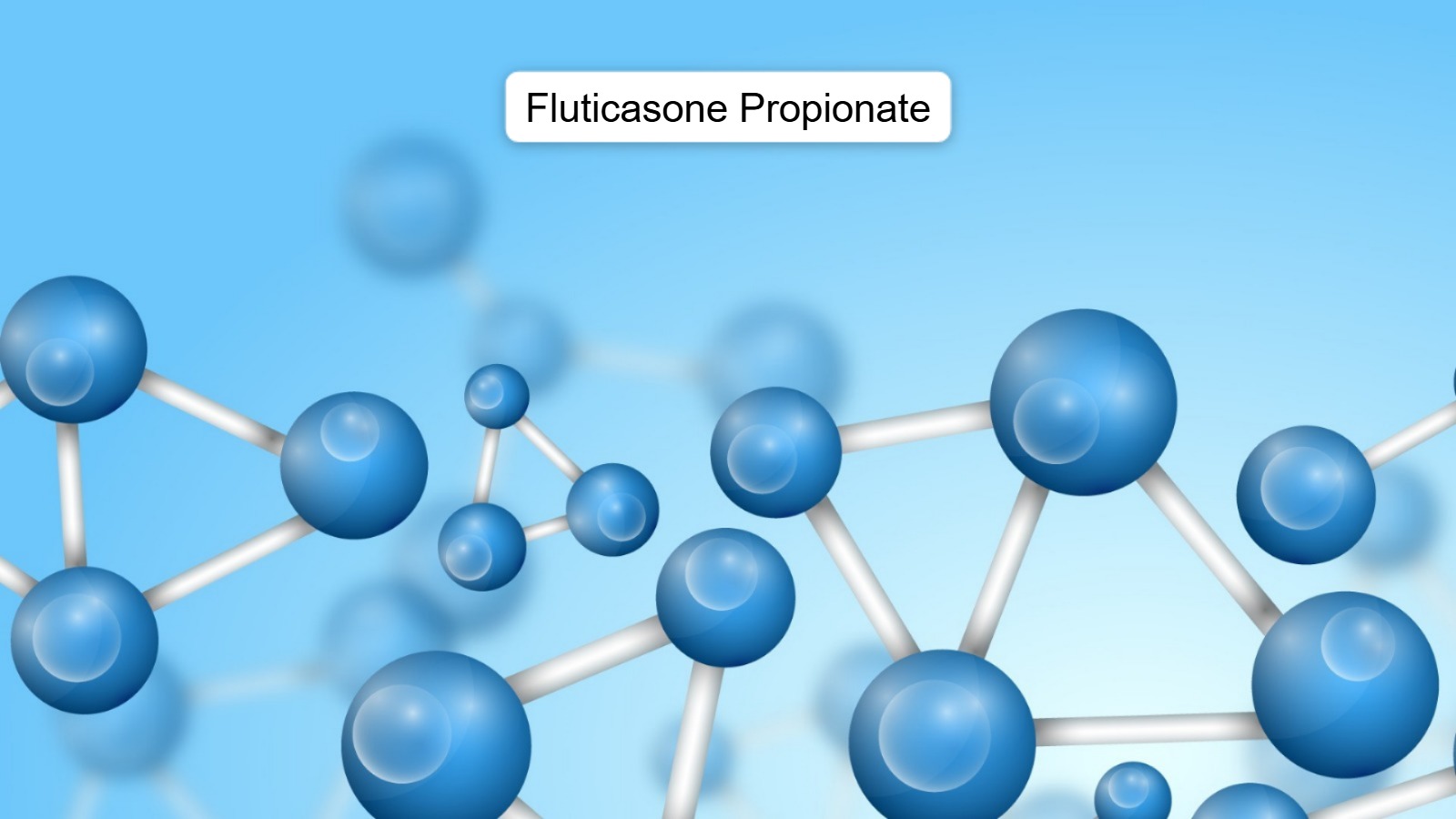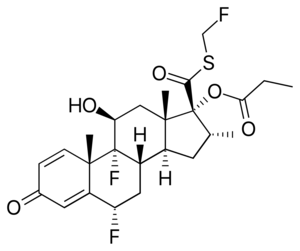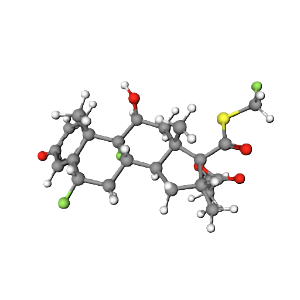
Fluticasone Propionate is a synthetic corticosteroid widely used to treat inflammatory conditions such as asthma, allergic rhinitis, and skin disorders. Its potent anti-inflammatory properties and targeted mechanism of action make it a cornerstone in respiratory and dermatological treatments. This guide explores Fluticasone Propionate’s structure, properties, pharmacology, uses, and safety profile.
1. Structure of Fluticasone Propionate
Understanding the molecular structure of Fluticasone Propionate reveals its efficacy as an anti-inflammatory agent.
2D Structure
The 2D structure of Fluticasone Propionate features a corticosteroid backbone with fluorine substitutions. These substitutions enhance its receptor-binding affinity and metabolic stability.

3D Structure
The 3D conformation of Fluticasone Propionate showcases its spatial arrangement, highlighting its ability to selectively bind to glucocorticoid receptors. This interaction reduces inflammation at the cellular level.

2. Names and Identifiers
Fluticasone Propionate is recognized under various names and identifiers in scientific and medical communities.
- IUPAC Name:
S-(fluoromethyl) 6α,9-difluoro-11β-hydroxy-16α-methyl-3-oxo-17α-propionyloxyandrosta-1,4-diene-17β-carbothioate - Molecular Formula:
C25H31F3O5S - Molecular Weight:
500.57 g/mol - CAS Registry Number:
80474-14-2 - Synonyms:
Flonase, Flovent, Cutivate
These identifiers aid in cataloging Fluticasone Propionate across pharmacological databases.
3. Chemical and Physical Properties
The chemical and physical properties of Fluticasone Propionate contribute to its clinical effectiveness.
| Property | Details |
|---|---|
| Appearance | White to off-white crystalline powder |
| Melting Point | ~273°C |
| Solubility | Slightly soluble in water; soluble in ethanol |
| LogP (Partition Coefficient) | ~3.7 |
| Chemical Class | Corticosteroid |
These properties make it suitable for formulations such as inhalers, nasal sprays, and topical creams.
4. Drug and Medication Information
Fluticasone Propionate is extensively used in managing respiratory and dermatological inflammatory conditions.
Formulations
- Inhalation:
- Available as metered-dose inhalers (MDIs) and dry powder inhalers (DPIs) for asthma and COPD (e.g., Flovent).
- Nasal Spray:
- Used for allergic rhinitis and nasal polyps (e.g., Flonase).
- Topical Cream:
- Treats skin conditions like eczema and psoriasis (e.g., Cutivate).
Mechanism of Action
Fluticasone Propionate works by:
- Suppressing Pro-Inflammatory Mediators: Reduces cytokines, prostaglandins, and leukotrienes.
- Binding to Glucocorticoid Receptors: Modulates gene expression to reduce inflammation.
- Minimizing Systemic Absorption: Ensures localized action to reduce side effects.
Dosage and Administration
- For Asthma:
- Inhale twice daily as prescribed.
- For Allergic Rhinitis:
- Use 1-2 sprays per nostril daily.
- For Skin Disorders:
- Apply a thin layer to the affected area once or twice daily.
Follow your doctor’s instructions for optimal results.
Explore a leading manufacturer of APIs.
With over 10 years of expertise, we ensure GMP compliance and provide reliable, high-quality solutions.
5. Pharmacology and Biochemistry
Fluticasone Propionate’s pharmacology highlights its role as a potent anti-inflammatory agent.
Pharmacokinetics
- Absorption:
Minimal systemic absorption when used topically or via inhalation. - Bioavailability:
<2% due to extensive first-pass metabolism in the liver. - Half-Life:
~8 hours. - Metabolism:
Metabolized in the liver by cytochrome P450 enzymes (CYP3A4). - Excretion:
Primarily eliminated via feces.
Pharmacodynamics
Fluticasone Propionate exerts its effects by modulating inflammatory responses, reducing swelling, redness, and irritation. Its targeted action on glucocorticoid receptors ensures effective symptom relief with minimal systemic effects.
6. Uses and Side Effects
Primary Uses
- Asthma and COPD:
Controls airway inflammation to prevent wheezing and shortness of breath. - Allergic Rhinitis:
Reduces nasal congestion, sneezing, and runny nose. - Dermatological Conditions:
Treats inflammatory skin disorders such as eczema, psoriasis, and dermatitis.
Benefits
- Rapid onset of action for inflammation relief.
- Long-lasting effects with consistent use.
- Safe for long-term management when used as directed.
Side Effects
Common side effects include:
- Hoarseness or throat irritation (inhalation).
- Nasal dryness or irritation (nasal spray).
- Mild skin irritation or burning sensation (topical use).
Rare but serious side effects:
- Adrenal suppression with prolonged use.
- Increased risk of infections.
- Delayed wound healing.
Contact your doctor if side effects persist or worsen.
7. Safety and Hazards
Safety Profile
Fluticasone Propionate is safe when used as directed. However:
- Contraindications: Not suitable for patients with untreated infections or hypersensitivity to corticosteroids.
- Pregnancy and Breastfeeding: Consult a doctor before use.
Chemical Safety

Handling Precautions
- Avoid contact with eyes.
- Do not use on open wounds or infected areas without medical advice.
Environmental Impact
Fluticasone Propionate degrades rapidly in the environment, minimizing ecological risks.
Chemignition Laboratory is a globally trusted manufacturer and exporter of Fluticasone Propionate Active Pharmaceutical Ingredients (API).
We specialize in APIs and provide complete documentation support including,
- GMP Certificate
- COA
- MSDS
- Stability Data
- Impurity Profile
- ISO 9001 Certificate
Customized packaging and cold chain logistics ensure safe delivery of sensitive APIs worldwide.
We proudly serve pharmaceutical companies across the USA, Europe, Asia, and more.
Partner with Chemignition Laboratory for consistent quality, regulatory compliance, and reliable global supply.
FAQs
IUPAC Name of Fluticasone Propionate?
S-(fluoromethyl) 6α,9-difluoro-11β-hydroxy-16α-methyl-3-oxo-17α-propionyloxyandrosta-1,4-diene-17β-carbothioate.
Molecular Formula Fluticasone Propionate?
C25H31F3O5S
Molecular Weight Fluticasone Propionate?
500.57 g/mol
CAS Number Fluticasone Propionate?
80474-14-2
What is Fluticasone Propionate used for?
Fluticasone Propionate is used to treat various inflammatory conditions, including:
- Asthma and COPD: Reduces airway inflammation and prevents wheezing and shortness of breath.
- Allergic Rhinitis: Relieves nasal congestion, sneezing, and runny nose.
- Skin Conditions: Treats eczema, psoriasis, and dermatitis.
How does Fluticasone Propionate work?
Fluticasone Propionate is a corticosteroid that works by binding to glucocorticoid receptors. It reduces the production of inflammatory mediators like cytokines and prostaglandins, thereby decreasing inflammation and swelling.
What are the common side effects of Fluticasone Propionate?
Common side effects include:
- Throat irritation or hoarseness (inhalation).
- Nasal dryness or irritation (nasal spray).
- Mild burning or itching (topical application).
